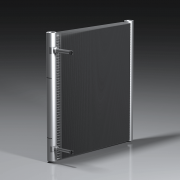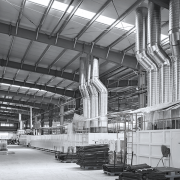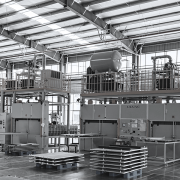Microchannel heat exchangers: comprehensive guide to the manufacturing process
The HVAC and refrigeration industries are undergoing transformative changes, driven by stricter energy efficiency regulations, environmental directives, and a growing demand for sustainable cooling technologies. Among the most impactful innovations is the adoption of microchannel heat exchangers (MCHEs) — compact, high-performance components designed to enhance thermal transfer efficiency while minimizing refrigerant charge.
Microchannel coils, built using all-aluminum construction, offer compelling advantages over conventional fin-and-tube designs, especially in terms of thermal efficiency, weight reduction, and corrosion resistance. This article explores the step-by-step fabrication process of microchannel heat exchangers, with an emphasis on aluminum brazing and quality assurance.
The Need for Microchannel Heat Exchangers
Microchannel technology is increasingly favored by HVAC manufacturers due to:
- Higher energy efficiency: Enhanced heat transfer through improved surface area utilization and metallurgical bonding.
- Lower refrigerant charge: Smaller internal volume significantly reduces the system’s environmental impact.
- Compact and lightweight design: Ideal for space-constrained or mobile applications.
- Improved durability: Aluminum construction offers inherent resistance to corrosion.
In contrast to finned tube coils, which rely on mechanical expansion to connect tubes and fins—often resulting in imperfect contact and high thermal resistance—MCHEs are assembled using a brazing process. This approach ensures strong, consistent bonds at the microscopic level, eliminating performance losses due to poor contact surfaces.
Detailed Manufacturing Process of Microchannel Heat Exchangers
1. Component Preparation and Core Assembly
The process begins with the preparation of key components: aluminum flat tubes, headers (manifolds), and louvered fins. These are automatically fed and assembled into a defined geometric configuration using a core builder machine. Fixturing strips are installed to maintain shape and alignment throughout the thermal processing stages.
Precise alignment at this stage is critical, as even minor deviations can affect heat exchanger geometry during brazing and brazing quality.
2. Thermal Degreasing
Before brazing, all assembly parts must be thoroughly cleaned. A thermal degreasing process is applied to remove manufacturing residues such as oils, lubricants, and particulates.
The coils are heated in a controlled environment, causing surface impurities to evaporate or decompose.
3. Fluxing
To enable successful brazing, it is necessary to eliminate the natural oxide film that forms on aluminum surfaces. This is achieved through the application of a flux solution, delivered as an aqueous slurry.
Then, air blow-off is used to remove excess flux slurry and evenly distribute it throughout the coil. The pre-fluxing technique can also be used for specific heat exchanger components like manifolds and flat tubes. Pre-fluxing includes spraying a mixture of flux and silicon powder using a binder.
Proper fluxing is essential for promoting metallurgical bonding and preventing oxidation during brazing.
4. Drying
Once fluxing is complete, the heat exchanger enters the drying phase, where residual water is evaporated at temperatures between 200°C and 250°C. Moisture removal is vital, as water vapor can interfere with the atmosphere in the brazing furnace, compromising joint integrity.
5. Brazing (Controlled Atmosphere Brazing – CAB)
Brazing is the core process that fuses the entire heat exchanger assembly into a solid, leak-free structure. This is done in a Controlled Atmosphere Brazing (CAB) furnace, a tunnel-type system filled with nitrogen to eliminate oxygen and prevent oxidation.
As the assembly travels through the furnace:
- Flux melts at ~565°C and begins to flow.
- Brazing alloy (typically an aluminum-silicon blend) melts at ~580°C and spreads via capillary action, filling gaps and joining surfaces.
- Oxide layers are neutralized by the flux, ensuring clean, strong joints.
Precise temperature control and atmosphere purity are critical in this phase. Oxygen and moisture levels must be tightly regulated (often <10 ppm O₂) to prevent oxidation and ensure brazing quality.
6. Cooling
After brazing, the coil is gradually cooled in a dedicated zone to solidify the filler metal and lock all parts into a stable, monolithic structure. A metallurgical bond is formed between all contact surfaces. Residual flux remains as a thin protective film (~1–2µm), which may or may not be removed depending on subsequent finishing steps.
Steps 3 through 6 of the microchannel heat exchanger manufacturing process—fluxing, drying, brazing, and cooling—are performed on a continuous, integrated conveyor line. The conveyor speed and thermal profile are precisely adjusted based on the physical parameters of each coil. This ensures optimal flux application, consistent drying, accurate brazing temperatures, and controlled cooling rates, all of which are essential for producing high-quality heat exchangers.
7. Testing and Inspection
Each heat exchanger undergoes rigorous quality assurance testing, including:
- Leak detection using pressurized nitrogen or helium.
- Visual inspections for brazing defects or deformities.
- Dimensional checks to ensure compliance with design tolerances.
Units that pass inspection may proceed to final packaging or additional processing, such as coil bending, hydrophilic coating, or e-coating for corrosion resistance, and following secondary leak inspection.
***
Microchannel heat exchangers represent a significant leap forward in heat transfer technology, offering superior efficiency, environmental compliance, and long-term reliability. Their manufacturing process—anchored by controlled atmosphere brazing and precise quality control—ensures high performance across HVAC and industrial applications.
Advancements in aluminum brazing play a pivotal role in driving the evolution and widespread adoption of microchannel heat exchanger technology. As brazing methods become increasingly precise, they enable manufacturers to reduce production costs, enhance mechanical strength, and significantly improve corrosion resistance—key factors in the performance and longevity of modern HVAC components.








